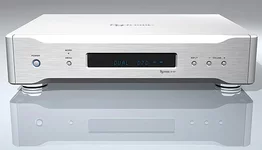Даешь 5 ! Кто больше ?

.
.
Вот на что надо равняться

Esoteric D-07 D/A processor
By John Atkinson • Posted: Jan 27, 2011
... I used two of the mono Esoteric D-01VU D/A converters locked to the ultra-high-precision Esoteric G-0Rb "atomic" master clock.
... relatively affordable D-07 D/A processor ($4800), I asked for a review sample.
... The D-07
This single-box processor, encased in 5mm-thick, sandblasted aluminum panels, echoes the appearance of Esoteric's E-03 phono preamplifier, which Michael Fremer favorably reviewed in the December 2010 issue. The front panel has an attractive scalloped profile, and a central recess for the blue alphanumeric display. The D-07 offers AES/EBU and S/PDIF inputs (the latter on two electrical jacks and one optical TosLink jack), as well as a USB input. There are also a TTL-compatible word-clock input and output, as well as balanced and single-ended analog outputs.
Front-panel pushbuttons control source selection and volume up/down; the latter buttons also operate in conjunction with a Menu button and the display to allow the operating mode to be set. The choices include: absolute polarity; conventional, linear-phase digital low-pass filter (called FIR) or a minimum-phase, apodizing type (referred to as S_DLY), both operating with 32-bit precision; no upsampling (Conv Off), or upsampling by factors of two or four, or to 1-bit, 64Fs DSD format; single- or dual-PLL input operation; what information is displayed; and use of an outboard word-clock generator.
The actual PCM upsampling ratio depends on the sample rate of the input data (Fs). For example, CD data at 44.1kHz can be upsampled by a factor of two (to 88.2kHz) or four (to 176.4kHz), while 88.2kHz and 96kHz can each be upsampled by only a factor of two (to 176.4kHz and 192kHz, respectively). Both the display and a green LED to the upper left of the display flash until the D-07 has successfully locked on to an input datastream. This LED also turns blue when the D-07 is sending or receiving a valid word-clock signal.
Inside the box
A hefty C-core AC transformer resides behind the front panel, feeding the power-supply circuit board, which runs almost the full depth of the chassis on the left. On the top right, at the rear of the chassis, sits the digital input/output board. The AES/EBU and S/PDIF inputs are routed to a high-quality AKM 4114 transceiver chip; the USB input feeds the popular Tenor chip, though it must be noted that this does not support native playback of 88.2kHz-sampled data, working only with 32, 44.1, 48, and 96kHz data. A large printed-circuit board with the D/A and analog output sections occupies most of the real estate beneath the digital I/O. This board also carries a small daughterboard, presumably to perform the upsampling function.
A 32-bit-wide data path is preserved up to the point of conversion, to maximize resolution. D/A conversion uses a single AKM 4392 chip per channel. This is a 32-bit type with differential outputs that can decode both PCM and DSD data, and includes a 256-step digital attenuator and an 8x oversampling digital filter. However, I assume that Esoteric implements the filter in one of the many FPGA chips on the board, in order to offer both minimum- and linear-phase types. The balanced output appears to be based on a Muses 8820, a fairly new, bipolar-input, dual–op-amp chip from JRC said to be optimized for high-end audio use. This is followed by discrete transistors, though I don't know if they are buffers or serve some other purpose. The single-ended output appears to be realized with a 5534 op-amp. Though this is a vintage chip, it is still one of the best choices for driving low impedances with low static distortion.
The parts quality is high, with multi-layer circuit boards used. The D-07 both looks attractive and is impressively well built.
...
⚠ Тільки зареєстровані користувачі бачать весь контент та не бачать рекламу.
.
 Хочется крутотень. Вера в Полковника! Под лозунгом - Hi-end в массы, даешь 4 слоя PCB!
Хочется крутотень. Вера в Полковника! Под лозунгом - Hi-end в массы, даешь 4 слоя PCB! Хочется крутотень. Вера в Полковника! Под лозунгом - Hi-end в массы, даешь 4 слоя PCB!
Хочется крутотень. Вера в Полковника! Под лозунгом - Hi-end в массы, даешь 4 слоя PCB!




